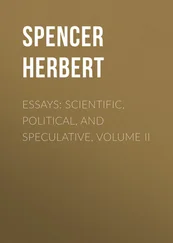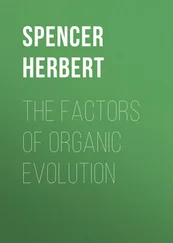And now let us consider the bearing of this general truth on the evolution of organisms. The germ of a plant or animal is one of these homogeneous aggregates—relatively homogeneous if not absolutely so—whose equilibrium is unstable. But it has not simply the ordinary instability of homogeneous aggregates: it has something more. For it consists of units which are themselves specially characterized by instability. The constituent molecules of organic matter are distinguished by the feebleness of the affinities which hold their component elements together. They are extremely sensitive to heat, light, electricity, and the chemical actions of foreign elements; that is, they are peculiarly liable to be modified by disturbing forces. Hence then it follows, a priori , that a homogeneous aggregate of these unstable molecules will have an excessive tendency to lose its equilibrium. It will have a quite special liability to lapse into a non-homogeneous state. It will rapidly gravitate towards heterogeneity.
Moreover, the process must repeat itself in each of the subordinate groups of organic units which are differentiated by the modifying forces. Each of these subordinate groups, like the original group, must gradually, in obedience to the influences acting on it, lose its balance of parts—must pass from a uniform into a multiform state. And so on continuously.
Thus, starting from the general laws of things, and the known chemical attributes of organic matter, we may conclude deductively that the homogeneous germs of organisms have a peculiar proclivity towards a non-homogeneous state; which may be either the state we call decomposition, or the state we call organization.
At present we have reached a conclusion only of the most general nature. We merely learn that some kind of heterogeneity is inevitable; but as yet there is nothing to tell us what kind. Besides that orderly heterogeneity which distinguishes organisms, there is the disorderly or chaotic heterogeneity, into which a loose mass of inorganic matter lapses; and at present no reason has been given why the homogeneous germ of a plant or animal should not lapse into the disorderly instead of the orderly heterogeneity. But by pursuing still further the line of argument hitherto followed we shall find a reason.
We have seen that the instability of homogeneous aggregates in general, and of organic ones in particular, is consequent on the various ways and degrees in which their constituent parts are exposed to the disturbing forces brought to bear on them: their parts are differently acted upon, and therefore become different. Manifestly, then, a rationale of the special changes which a germ undergoes, must be sought in the particular relations which its several parts bear to each other and to their environment. However it may be masked, we may suspect the fundamental principle of organization to be, that the many like units forming a germ acquire those kinds and degrees of unlikeness which their respective positions entail.
Take a mass of unorganized but organizable matter—either the body of one of the lowest living forms, or the germ of one of the higher. Consider its circumstances. It is immersed in water or air; or it is contained within a parent organism. Wherever placed, however, its outer and inner parts stand differently related to surrounding existences—nutriment, oxygen, and the various stimuli. But this is not all. Whether it lies quiescent at the bottom of the water, whether it moves through the water preserving some definite attitude, or whether it is in the inside of an adult; it equally results that certain parts of its surface are more directly exposed to surrounding agencies than other parts—in some cases more exposed to light, heat, or oxygen, and in others to the maternal tissues and their contents. The destruction of its original equilibrium is therefore certain. It may take place in one of two ways. Either the disturbing forces may be such as to overbalance the affinities of the organic elements, in which case there results that chaotic heterogeneity known as decomposition; or, as is ordinarily the case, such changes are induced as do not destroy the organic compounds, but only modify them: the parts most exposed to the modifying forces being most modified. Hence result those first differentiations which constitute incipient organization. From the point of view thus reached, suppose we look at a few cases: neglecting for the present all consideration of the tendency to assume the inherited type.
Note first what appear to be exceptions, as the Amœba . In this creature and its allies, the substance of the jelly-like body remains throughout life unorganized—undergoes no permanent differentiations. But this fact, which seems directly opposed to our inference, is really one of the most significant evidences of its truth. For what is the peculiarity of the Rhizopods, exemplified by the Amœba ? They undergo perpetual and irregular changes of shape—they show no persistent relations of parts. What lately formed a portion of the interior is now protruded, and, as a temporary limb, is attached to some object it happens to touch. What is now a part of the surface will presently be drawn, along with the atom of nutriment sticking to it, into the centre of the mass. Thus there is an unceasing interchange of places; and the relations of inner and outer have no settled existence. But by the hypothesis, it is only in virtue of their unlike positions with respect to modifying forces, that the originally-like units of a living mass become unlike. We must not therefore expect any established differentiation of parts in creatures which exhibit no established differences of position in their parts.
This negative evidence is borne out by abundant positive evidence. When we turn from these ever-changing specks of living jelly to organisms having unchanging distributions of substance, we find differences of tissue corresponding to differences of relative position. In all the higher Protozoa , as also in the Protophyta , we meet with a fundamental differentiation into cell-membrane and cell-contents, answering to that fundamental contrast of conditions implied by the words outside and inside. And on passing from what are roughly classed as unicellular organisms to the lowest of those which consist of aggregated cells, we equally observe the connexion between structural differences and differences of circumstance. In the sponge, permeated throughout by currents of sea-water, the absence of definite organization corresponds with the absence of definite unlikeness of conditions. In the Thalassicolla of Professor Huxley—a transparent, colourless body, found floating passively at the surface of the sea, and consisting essentially of "a mass of cells united by jelly"—there is displayed a rude structure obviously subordinated to the primary relations of centre and surface: in all of its many and important varieties, the parts exhibit a more or less concentric arrangement.
After this primary modification, by which the outer tissues are differentiated from the inner, the next in order of constancy and importance is that by which some part of the outer tissues is differentiated from the rest; and this corresponds with the almost universal fact that some part of the outer tissues is more directly exposed to certain environing influences than the rest. Here, as before, the apparent exceptions are extremely significant. Some of the lowest vegetable organisms, as the Hematococci and Protococci , evenly imbedded in a mass of mucus, or dispersed through the Arctic snow, display no differentiations of surface: the several parts of the surface being subjected to no definite contrasts of conditions. The Thalassicolla above mentioned, unfixed, and rolled about by the waves, presents all its sides successively to the same agencies; and all its sides are alike. A ciliated sphere like the Volvox has no parts of its periphery unlike other parts; and it is not to be expected that it should have; seeing that as it revolves in all directions, it does not, in traversing the water, permanently expose any part to special conditions. But when we come to creatures that are either fixed, or while moving, severally preserve a definite attitude, we no longer find uniformity of surface. The gemmule of a Zoophyte, which during its locomotive stage is distinguishable only into outer and inner tissues, no sooner takes root than its upper end begins to assume a different structure from its lower. The free-swimming embryo of an aquatic annelid, being ovate and not ciliated all over, moves with one end foremost; and its differentiations proceed in conformity with this contrast of circumstances.
Читать дальше












